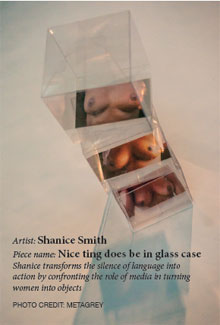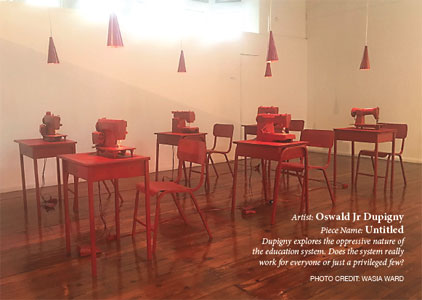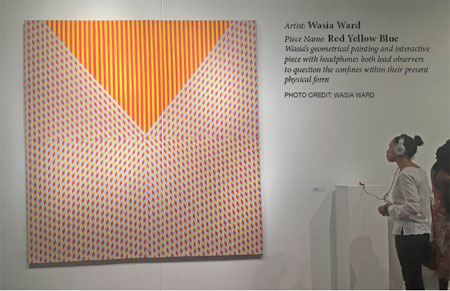
“To the UWI graduates in the audience tonight, don’t rest on your laurels. This is just the beginning. The concepts that you have presented here today will plague you for the rest of your lives.”
 National Museum Curator Lorraine Johnson’s opening remarks cast a precarious overtone on the densely packed crowd. This was the Department of Creative and Festival Arts (DCFA) Visual Arts Degree Programme Final Year Exhibition opening ceremony. Friends, family and enthused arts patrons gathered in the Main Gallery of the National Museum and Art Gallery on April 13 to observe the works of 22 Fine Art and 17 Design students who presented the final progression of their Visual Arts degree portfolio after receiving peer review, critiques and measured guidance from their fellow students and lecturers at DCFA. National Museum Curator Lorraine Johnson’s opening remarks cast a precarious overtone on the densely packed crowd. This was the Department of Creative and Festival Arts (DCFA) Visual Arts Degree Programme Final Year Exhibition opening ceremony. Friends, family and enthused arts patrons gathered in the Main Gallery of the National Museum and Art Gallery on April 13 to observe the works of 22 Fine Art and 17 Design students who presented the final progression of their Visual Arts degree portfolio after receiving peer review, critiques and measured guidance from their fellow students and lecturers at DCFA.
Organized by Keomi Serrette, Curatorial Assistant at the National Museum and Art Gallery, the exhibit was a collaborative effort between the National Museum and DCFA with Exhibition Curator, Steve Ouditt at the helm and Lauren Jennings-Stoute being an instrumental figure in the Exhibition Committee.
Fitting the range of issues addressed by the students neatly under one umbrella would be impossible as students explored everything, from the cultural preservation of Amerindian art to child sexual abuse and other difficult topics. Lecturer Steve Ouditt sees this as the contemporary way forward for artists: confronting social concerns and solutions.
“What we’re doing is giving students a chance to experiment with all of these ideas in their social space. Even going back in history, we would always see interventions and social projects have always been mediated by artists and the ways in which people come to understand a social space and system.”
Fine art student, Oswald Jr Dupigny’s Untitled piece provides a clear depiction of the way in which the education system shapes our social consciousness based on the privileging of academia over vocational abilities. The two collide in a flaming red classroom filled with school desks and sewing machines. Dupigny credits the secure foundation DCFA provided to help him get to this point, “The programme has helped me mature and I take my craft seriously now and I’ve come to know what I’m about in terms of my art making, process, studio etc.”
Helping students find their niche was a recurring theme among the students interviewed, including Design student Melissa Miller, whose Herban – an urban herb garden system encourages sustainability in a practical solution for busy city professionals who don’t have the time to maintain an entire garden.
 “With design and art, you really have to have a passion for whatever you’re doing and it’s okay to have a specific niche... it can be overwhelming at first since we’re exposed to so much in the beginning, but once you keep working on your own skill, you can decide what niche works best for you.” “With design and art, you really have to have a passion for whatever you’re doing and it’s okay to have a specific niche... it can be overwhelming at first since we’re exposed to so much in the beginning, but once you keep working on your own skill, you can decide what niche works best for you.”
Sometimes your niche ends up miles away from where you started according to Shanice Smith, conceptual fine arts student.
“I came into the programme with the intention of learning to paint and draw and I disliked contemporary art sooo much,” she said. “Only in my second year, I started reflecting and trying to open up about things and find a middle ground or safe space. I've learnt more about contemporary art since then and I realized that it is relevant to the times we live in and the objectification of women IS very much relevant.”
Smith’s piece, Nice ting does be in glass case is part of a body of work investigating gender-based issues faced by females, specifically the objectification and the role of the media. When confronted with the plethora of uncovered breasts in the piece, museum onlookers’ reactions vacillated from thoughtfully glancing back and forth between the description and the piece to understand it to raised eyebrows and spontaneous trini bemusement, “Weeyyyysssss.”
Undoubtedly, the piece sparked conversation and intrigue by all in attendance.
The chasm between the artists’ intentions and the audience’s interpretation remains a space that both challenges and excites both parties. Does good art always transmit a clear meaning or is it meant to simply provoke the viewer? Also, how do we cultivate artists of this calibre? According to Lauren Jennings-Stoute, the students at this exhibit pulled of such a feat because they were self-motivated and had the drive to present and promote a unique show that was of the highest standard. This is in spite of budgetary constraints and other setbacks.
 Director of the DCFA, Jessel Murray, makes no secret of the need for DCFA to have its own space and spoke about the University’s plans to house a new expanded space at Cheeseman Avenue, St. Augustine in 2017. In the interim, students like Lauren Jennings-Stoute were happy to showcase their work in a prominent venue like the National Museum, but also saw the need for DCFA to develop more strategically in keeping with national policy for a competitive advantage in the creative arts. Similarly Steve Ouditt saw the example of Havana Cuba, as a prototype for how Trinidad could continue creating cutting-edge art, design and music despite economic challenges. Director of the DCFA, Jessel Murray, makes no secret of the need for DCFA to have its own space and spoke about the University’s plans to house a new expanded space at Cheeseman Avenue, St. Augustine in 2017. In the interim, students like Lauren Jennings-Stoute were happy to showcase their work in a prominent venue like the National Museum, but also saw the need for DCFA to develop more strategically in keeping with national policy for a competitive advantage in the creative arts. Similarly Steve Ouditt saw the example of Havana Cuba, as a prototype for how Trinidad could continue creating cutting-edge art, design and music despite economic challenges.
Overall, any initial connotations of amateur, apprentice-like work proved to be a misnomer as students punched way above their weight, whether through combining principles of design and horticulture for therapy methodology in the case of Ryan Huggins, Holographic Entrypoint (Bromeliads) or investigating the theory that all things will eventually become different versions of themselves in Wasia Ward’s Red Yellow Blue. In Ward’s words, “The graduating class challenged the stereotype of what art could be and got audience to see their installations as ‘real art.’”
The opening indeed was a night of triumph, spectacle and celebration. But the work of the artist remains to be continued…
Jeanette G. Awai is a freelance writer and a Marketing and Communications Assistant at the UWI St. Augustine Marketing and Communications Office
The UWI DCFA Visual Arts Degree Programme Exhibition runs until May 14 at the National Museum and Art Gallery, Port of Spain, corner Frederick Street and Keate Street, Port of Spain.
Works of the artists can be viewed at: https://dcfafaad2016.wordpress.com. |





